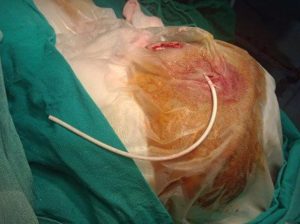Heyer-Schulte ventricular catheters incorporate tantalum-impregnated tips to aid in determining exact positioning by x-ray examination. The accurate placement and sizes of holes to permit unobstructed drainage determined as a result of many years of clinical evaluation.
MPF VENTRICULAR CATHETER (Multi-Perforated Flange)
Many small holes on the underside of the silicone flanges strain fluid as it passes through to the larger holes in the catheter tube to resist occlusion by floating debris. The flanges reduce the chance that the catheter will rest against the wall of the ventricle or the choroid plexus. The flanges fold back during insertion and resume their normal expanded position after they enter the ventricle.
A stainless steel stylet is furnished to support and direct the catheter during insertion. Radiopaque, with additional black radiopaque markers at 10 and 15 cm from the tip to assist in positioning. X-ray detectable tip. The spring reinforced model has a spring embedded in the catheter to help eliminate kinking and provide greater latitude in positioning. 
PORTNOY VENTRICULAR CATHETER
Multiple flanges help prevent the three major causes of obstruction: Clogging catheter holes with brain debris on insertion; placing the catheter against the ventricular wall or choroid plexus; occlusion of the catheter holes as the ventricular cavity collapses during decompression.
Radiopaque with additional black radiopaque markers at 10 and 15 cm from the tip to assist in positioning. X-ray detectable tip.
A stainless steel stylet is furnished to support and direct the catheter during insertion.
MATHEWS VENTRICULAR CATHETER
Unique radiopaque markers at 1 cm intervals along the length of the catheter allow accurate length and placement determination by either direct viewing or X-ray.
Multiple small holes in the catheter wall at the tip reduce the migration of particulate matter into the lumen.
PUDENZ VENTRICULAR CATHETER
Forty small holes located within the first 11/2 cm of the end facilitate drainage. The tip closed to prevent debris from entering the catheter during placement.
X-ray detectable tip. Available in clear silicone rubber, barium impregnated silicone rubber, or with stainless steel spring reinforcement.
Standard
Barium Impregnated
RIGHT ANGLE VENTRICULAR CATHETER
Pre-formed right angle bend allows the use of a straight connector to fasten the flushing device to the ventricular catheter.
Produced from barium impregnated silicone elastomer.
The designated size is the length from tip to 90° bend. Other sizes are available on special order.
GARNER BALLOON VENTRICULAR CATHETER
A unique inflatable balloon at the tip helps prevent penetration into brain substance and reduces clogging.
After insertion, the balloon filled with air so that the tip will float in the anterior portion of the ventricle and avoid the choroid plexus. Usually, resistance can be felt when the balloon reaches the frontal horn. The air is withdrawn and a like quantity of saline introduced to maintain expansion. The inflation lumen ligated and the catheter trimmed to the desired length. Attached to the flushing device with an X-ray detectable tip.
CARREA CAGE VENTRICULAR CATHETER
The mushroom-shaped ventricular end helps to hold the catheter away from the ventricle walls. The drainage holes in the catheter wall lead through the center section of the cage construction. Their size and positioning help reduce particulate matter from entering the catheter lumen and causing obstructions. X-ray detectable tip.
